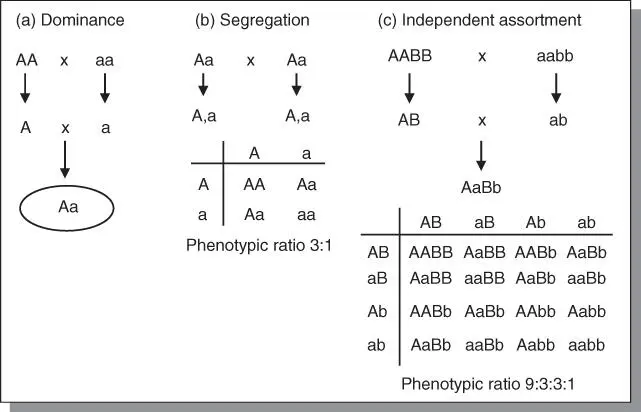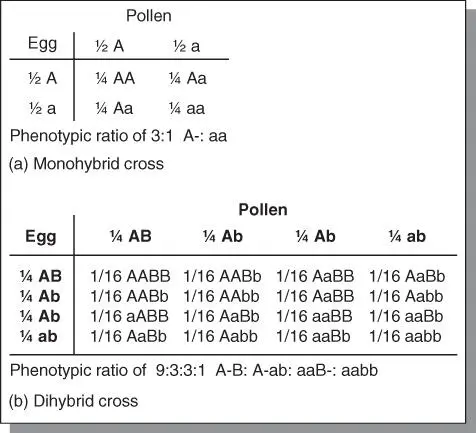Some flowers are complete (possess all the four basic parts) while others are incomplete (are missing one or more of the four basic floral parts). Furthermore, in some species, the sexes are separate. When separate male and female flowers occur on the same plant, the condition is called monoecy.Sometimes, the male and female flowers occur in different kinds of inflorescence (different locations as in corn). Other examples of monoecious plants include most figs, birch, and pine trees. It is easier and more convenient to self‐pollinate plants when the sexes occur in the same inflorescence. In terms of seed production, monoecy and dioecy may appear to be inefficient because not all flowers produce seed. Some flowers produce only pollen.
When the sexes occur on different plants (i.e. there are female plants and male plants), the condition is called dioecy. Examples of dioecious crop species include date, hops, asparagus, spinach, holly, and hemp. The separation of the sexes means that by necessity all seed from dioecious species are hybrid in composition. Where the economic product is the seed or fruit, it is imperative to have female and male plants in the field in an appropriate ratio. In dioecious fruit orchards (e.g. date, persimmons), 3–4 males per 100 females may be adequate. In hops, the commercial product is the female inflorescence. Unfertilized flowers have the highest quality. Consequently, it is not desirable to grow pollinators in the same field when growing hops. Dioecious crops propagated by seed may be improved by mass selection or controlled hybridization.
5.8.2 Genetic and breeding implications of allogamy
The genotype of the sporophytic generation is highly heterozygous while the genotypes of gametes of a single plant are all different. The genetic structure of a cross‐pollinated species is characterized by a high level of heterozygosity. However, this is not to say that at each locus heterozygosity occurs. Especially when the allele frequency of certain genes is high (see Chapter 3), a plant may very well be homozygous for that locus. Another source of some homozygosity may be due to occasional selfing in a plant. Unlike allogamous species in which formation of new gene combinations are discouraged, cross‐pollinated species share a wide gene pool from which new combinations are created to form the next generation.
It is instructive to state that in autogamous crops in principle the whole genotype is transmitted through the generations (i.e. they are “immortal”). Homozygous plants reproduce genetically identically. Consequently, the unit of selection in a mixture of homozygous lines is genotype. In contrast, in allogamous crops, the unit of selection is the single gene. The gene in this case is “immortal.” Genotypes perish (lose their identity) at each round of sexual reproduction. The only way the genotype can become immortal and be the unit of selection in allogamous crops is when they are clonally propagated, as is the case in potato.
Allogamous species may to a varying extent undergo self‐fertilization. In that case the progeny usually suffers from inbreeding depression. Deleterious recessive alleles that were suppressed because of heterozygous advantage have opportunities to become homozygous and therefore become expressed. However, such depression is reversed upon cross‐pollination. Hybrid vigor(the increase in vigor of the hybrid over its partially homozygous and distinct parents) is exploited in hybrid seed production (see Chapter 18). In addition to hybrid breeding, population‐based improvement methods (e.g. mass selection, recurrent selection, and synthetic cultivars) are common methods of breeding cross‐pollinated species.
As previously stated, inbreeding or crossing closely related parents results in reduced fitness or vigor of individuals in the progenitor population, a condition called inbreeding depression. Reduction in fitness is usually manifested as a reduction in vigor, fertility, and productivity, and seen as lower biomass per plant, lower fecundity, malformation of organs, and lower germination of seeds. The effect of inbreeding is more severe in the early generations (five to eight) than in later generations. Just like heterosis, inbreeding depression is not uniformly manifested in plants. Plants including onions, sunflower, cucurbits, maize, and rye are rather tolerant of inbreeding with low or no inbreeding depression. On the other hand, crops such as alfalfa and carrot are highly intolerant of inbreeding.
5.9 Mendelian concepts relating to the reproductive system
As previously stated, genetics is the principal science that underlies plant breeding. Mendel derived several postulates or principles of inheritance, which are often couched as Mendel's Laws of inheritance. Genes are transferred from parents to offspring following mating or crossing. Mendel's principles are best illustrated using self‐pollinated species as was the case in his original experiments.
5.9.1 Mendelian postulates
Because plant breeders transfer genes from one source to another, an understanding of transmission geneticsis crucial to a successful breeding effort. The method of breeding used depends upon the heredity of the trait being manipulated, among other factors. According to Mendel's results from his hybridization studies in pea, traits are controlled by heritable factors that are passed from parents to offspring, through the reproductive cells. Each of these unit factors occurs in pairs in each cell (except reproductive cells or gametes).
In his experiments, Mendel discovered that in a cross between parents displaying two contrasting traits, the hybrid (F 1) expressed one of the traits to the exclusion of the other. He called the expressed trait dominantand the suppressed trait recessive. This is the phenomenon of dominanceand recessivity. When the hybrid seed was planted and self‐pollinated, he observed that both traits appeared in the second generation (F 2) (i.e. the recessive trait reappeared), in a ratio of 3 : 1 dominant: recessive individuals ( Figures 5.12and 5.13). Mendel concluded that the two factors that control each trait do not blend but remain distant throughout the life of the individual and segregate in the formation of gametes. This is called the law of segregation. In further studies in which he considered two characters simultaneously, he observed that the genes for different characters are inherited independently of each other. This is called the law of independent assortment. In summary, the two key laws are as follows:
1 Law I: Law of segregation: Paired factors segregate during the formation of gametes in a random fashion such that each gamete receives one form or the other.
2 Law II: Law of independent assortment: When two or more pairs of traits are considered simultaneously, the factors for each pair of traits assort independently to the gametes.

Figure 5.12Mendel's postulates: (a) dominance, (b) segregation, and (c) independent assortment.

Figure 5.13The Punnett square procedure may be used to demonstrate the events that occur during hybridization and selfing: (a) a monohybrid cross, and (b) a dihybrid cross shows the proportions of genotypes in the F 2population and the corresponding Mendelian phenotypic and genotypic ratios.
Читать дальше














